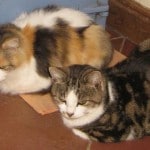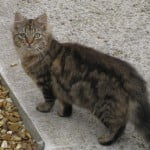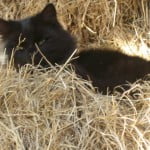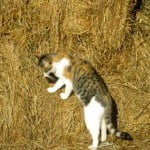Pet Advice Guides for Pet Owners
How to keep outside cats warm
Mischa and her daughter, Myrtle don’t like to go outside when it’s even a tiny bit cold. Certainly not when it’s raining and forget it when there’s snow about. Snuggling up by a warm radiator is all they think about this time of year. But we inevitably have cats in the sanctuary who are not inclined to be indoors, they hate to be confined.
Nelson is one of these ‘free spirits’ – he will allow us to pick him up and can be stroked when he’s eating, but close that door behind him and he freaks out. We have had numerous calls recently from people who have semi-wild cats in their garden. An outside shed is a good summer des-res but not warm enough for winter. Cat cabins are a good solution but very expensive. There are other cheaper alternatives.
Insulation is the answer. A box or hutch, preferably inside another building to which the cats have access, it could be a garden shed, garage or open porch, (but not a greenhouse which is way too cold) can provide a cosy den for a feral feline. It will need to be sheeted throughout with foam, the sort that is used to line walls or the roof space. Any sort will do though. We cut it to size and stick or tack it in place. If it has a lining sheet on, that’s enough. If it’s the flaky, crumbly type, you will have to put another cover over it. Plastic or cardboard will do. This is a temporary fix to last the winter. If you can’t line inside because it’s too confined, then put the insulation on the outside and then nail something waterproof over it. It can be as elaborate and scenic or basic and rough and ready as you wish. The main thing is that it will keep the cats warm.
When you have the new panels in place it’s time to fill up inside and the best material for this is hay. You can buy it in bags from the pet stores or better still, get a bale from a farmer. Watch out for ‘Hay for Sale’ signs – it will be anything from £2.50 to £4.00 a bale but much cheaper in the long run. Hay is wonderful insulation, it actually makes heat which is why haystacks sometimes catch fire, especially when the grass is newly cut in the summer.
Do you know that it’s possible to cook your dinner in a hay box? This is a survival technique – fill a wooden box with lots of hay and put a stoneware dish with your meal inside it and it will cook within a few hours. I’ve not tried this one mind. Fill the cat cabin with hay and pat it down in the middle to make a cosy place. Cats, and dogs too, love hay and will make their own nest. Animals appreciate natural materials, it’s the man made plastics and artificial scents that they don’t like. The entrance should be cat flap size to keep the cold out and keep the hay well back so that it doesn’t get damp. A rabbit hutch makes an ideal cat cabin when fitted out in this way. You can put biscuits and water in a dish in one side, the hay in the other.
Check the hay nest from time to time, if it is at all damp you can put it on the compost heap and re-fill. If you put blankets in they will soon get damp and then the cats will be colder than before. A bit of shredded paper is good though. If you live on a farm and have a haystack you will know that is where the cats spend their winters. They are cosy and warm in their hay burrows, it’s the ‘wild’ town cats that have the most difficulty in keeping warm.
This is Mr.Fluffy, who has been with us for many years and loves the haystack. He will be caught – sometimes!
Tansy is another ‘free spirit’ – she alternates between the barn and the stables. Tansy is a dedicated hunter and maybe it is the thrill of the chase that keeps her outside. We find that even the most ‘spooky’ feral cat will find the dish of biscuits and the hay nest and before long they will be snuggled up inside and warm at last.




